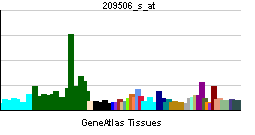COUP-TFI
| Nuclear receptor subfamily 2, group F, member 1 | |||||||||||
|---|---|---|---|---|---|---|---|---|---|---|---|
| Identifiers | |||||||||||
| Symbols | NR2F1 ; COUP-TFI; EAR-3; EAR3; ERBAL3; NR2F2; SVP44; TCFCOUP1; TFCOUP1 | ||||||||||
| External IDs | Template:OMIM5 Template:MGI HomoloGene: 21158 | ||||||||||
| |||||||||||
| RNA expression pattern | |||||||||||
 | |||||||||||
 | |||||||||||
| More reference expression data | |||||||||||
| Orthologs | |||||||||||
| Template:GNF Ortholog box | |||||||||||
| Species | Human | Mouse | |||||||||
| Entrez | n/a | n/a | |||||||||
| Ensembl | n/a | n/a | |||||||||
| UniProt | n/a | n/a | |||||||||
| RefSeq (mRNA) | n/a | n/a | |||||||||
| RefSeq (protein) | n/a | n/a | |||||||||
| Location (UCSC) | n/a | n/a | |||||||||
| PubMed search | n/a | n/a | |||||||||
COUP-TFI (COUP transcription factor 1), also known as NR2F1 (nuclear receptor subfamily 2, group F, member 1) is a human protein encoded by the NR2F1 gene.[1]
This protein is a member of nuclear hormone receptor family of steroid hormone receptors. Coup (chicken ovalbumin upstream promoter)) transcription factor binds to the ovalbumin promoter and, in conjunction with another protein (S300-II) stimulates initiation of transcription. Binds to both direct repeats and palindromes of the 5'-AGGTCA-3' motif. It interacts with COPS2.
References
Further reading
- Kliewer SA, Umesono K, Heyman RA; et al. (1992). "Retinoid X receptor-COUP-TF interactions modulate retinoic acid signaling". Proc. Natl. Acad. Sci. U.S.A. 89 (4): 1448–52. PMID 1311101.
- Berrodin TJ, Marks MS, Ozato K; et al. (1992). "Heterodimerization among thyroid hormone receptor, retinoic acid receptor, retinoid X receptor, chicken ovalbumin upstream promoter transcription factor, and an endogenous liver protein". Mol. Endocrinol. 6 (9): 1468–78. PMID 1331778.
- Ing NH, Beekman JM, Tsai SY; et al. (1992). "Members of the steroid hormone receptor superfamily interact with TFIIB (S300-II)". J. Biol. Chem. 267 (25): 17617–23. PMID 1517211.
- Wang LH, Tsai SY, Cook RG; et al. (1989). "COUP transcription factor is a member of the steroid receptor superfamily". Nature. 340 (6229): 163–6. doi:10.1038/340163a0. PMID 2739739.
- Miyajima N, Kadowaki Y, Fukushige S; et al. (1989). "Identification of two novel members of erbA superfamily by molecular cloning: the gene products of the two are highly related to each other". Nucleic Acids Res. 16 (23): 11057–74. PMID 2905047.
- Qiu Y, Krishnan V, Zeng Z; et al. (1996). "Isolation, characterization, and chromosomal localization of mouse and human COUP-TF I and II genes". Genomics. 29 (1): 240–6. PMID 8530078.
- Sawaya BE, Rohr O, Aunis D, Schaeffer E (1996). "Chicken ovalbumin upstream promoter transcription factor, a transcriptional activator of HIV-1 gene expression in human brain cells". J. Biol. Chem. 271 (38): 23572–6. PMID 8798567.
- Rohr O, Aunis D, Schaeffer E (1998). "COUP-TF and Sp1 interact and cooperate in the transcriptional activation of the human immunodeficiency virus type 1 long terminal repeat in human microglial cells". J. Biol. Chem. 272 (49): 31149–55. PMID 9388268.
- Dressel U, Thormeyer D, Altincicek B; et al. (1999). "Alien, a highly conserved protein with characteristics of a corepressor for members of the nuclear hormone receptor superfamily". Mol. Cell. Biol. 19 (5): 3383–94. PMID 10207062.
- Klinge CM, Kaur K, Swanson HI (2000). "The aryl hydrocarbon receptor interacts with estrogen receptor alpha and orphan receptors COUP-TFI and ERRalpha1". Arch. Biochem. Biophys. 373 (1): 163–74. doi:10.1006/abbi.1999.1552. PMID 10620335.
- Rohr O, Schwartz C, Hery C; et al. (2000). "The nuclear receptor chicken ovalbumin upstream promoter transcription factor interacts with HIV-1 Tat and stimulates viral replication in human microglial cells". J. Biol. Chem. 275 (4): 2654–60. PMID 10644726.
- Sugiyama T, Wang JC, Scott DK, Granner DK (2000). "Transcription activation by the orphan nuclear receptor, chicken ovalbumin upstream promoter-transcription factor I (COUP-TFI). Definition of the domain involved in the glucocorticoid response of the phosphoenolpyruvate carboxykinase gene". J. Biol. Chem. 275 (5): 3446–54. PMID 10652338.
- Vlahou A, Flytzanis CN (2000). "Subcellular trafficking of the nuclear receptor COUP-TF in the early embryonic cell cycle". Dev. Biol. 218 (2): 284–98. doi:10.1006/dbio.1999.9456. PMID 10656770.
- Avram D, Fields A, Pretty On Top K; et al. (2000). "Isolation of a novel family of C(2)H(2) zinc finger proteins implicated in transcriptional repression mediated by chicken ovalbumin upstream promoter transcription factor (COUP-TF) orphan nuclear receptors". J. Biol. Chem. 275 (14): 10315–22. PMID 10744719.
- Gay F, Anglade I, Gong Z, Salbert G (2001). "The LIM/homeodomain protein islet-1 modulates estrogen receptor functions". Mol. Endocrinol. 14 (10): 1627–48. PMID 11043578.
- You M, Fischer M, Cho WK, Crabb D (2002). "Transcriptional control of the human aldehyde dehydrogenase 2 promoter by hepatocyte nuclear factor 4: inhibition by cyclic AMP and COUP transcription factors". Arch. Biochem. Biophys. 398 (1): 79–86. doi:10.1006/abbi.2001.2713. PMID 11811951.
- Lin F, Kolluri SK, Chen GQ, Zhang XK (2002). "Regulation of retinoic acid-induced inhibition of AP-1 activity by orphan receptor chicken ovalbumin upstream promoter-transcription factor". J. Biol. Chem. 277 (24): 21414–22. doi:10.1074/jbc.M201885200. PMID 11934895.
- Métivier R, Gay FA, Hübner MR; et al. (2002). "Formation of an hER alpha-COUP-TFI complex enhances hER alpha AF-1 through Ser118 phosphorylation by MAPK". EMBO J. 21 (13): 3443–53. doi:10.1093/emboj/cdf344. PMID 12093745.
- Strausberg RL, Feingold EA, Grouse LH; et al. (2003). "Generation and initial analysis of more than 15,000 full-length human and mouse cDNA sequences". Proc. Natl. Acad. Sci. U.S.A. 99 (26): 16899–903. doi:10.1073/pnas.242603899. PMID 12477932.
- Yu X, Mertz JE (2003). "Distinct modes of regulation of transcription of hepatitis B virus by the nuclear receptors HNF4alpha and COUP-TF1". J. Virol. 77 (4): 2489–99. PMID 12551987.
This article incorporates text from the United States National Library of Medicine, which is in the public domain.
| This protein-related article is a stub. You can help Wikipedia by expanding it. |